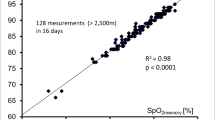Abstract
The recent expansion in the geographical areas open to human activity has made it desirable to have an objective method to evaluate the degree of high-altitude acclimatization. In this study, we measured the arterial oxygen saturation value at rest and just after exercise in healthy high-altitude trekkers using a transportable pulse oximeter. During a 100-day stay at high altitude (around 4000 m), the degree of arterial hemoglobin saturation measured at rest was relatively stable. However, shortly after arrival at high altitude, even light exercise induced an acute reduction in the degree of arterial hemoglobin saturation; this reduction was ameliorated as the trekkers became acclimatized to the high altitude. Preliminary short trekking to high altitudes does not appear sufficient to induce this response. It is suggested that this rapid and simple physiological examination, the measurement of arterial oxygen saturation value after light exercise, could be a convenient means of estimating the level of high-altitude acclimatization among healthy subjects.
Similar content being viewed by others
References
Bencowitz HZ, Wagner PD, West JB (1982) Effect of change in P50 on exercise tolerance at high altitude: a theoretical study. J Appl Physiol: Respir Environ Exercise Physiol 53:1487–1495
Ganong WF (1993) Respiration. In: Ganong WF (ed) Review of medical physiology. Lange Medical, Los Altos, Calif. pp 507–548
Groves BM, Droma T, Sutton JR, McCullough RG, McCullough RE, Zhuang J, Rapmund G, Sun S, Janes C, Moore LG (1993) Minimal hypoxic pulmonary hypertension in normal Tibetans at 3,658 m. J Appl Physiol 74:312–318
Hochachka PW (1992) Muscle enzymatic composition and metabolic regulation in high altitude adapted natives. Int J Sports Med 13 (Suppl):89–91
Hochachka PW, Clark CM, Brown WD, Stanley C, Stone SK, Nickles RJ, Zhu GG, Allen PS, Holden JE (1994) The brain at high altitude: hypometabolism as a defense against chronic hypoxia? J Cereb Blood Flow Metab 14:671–679
King SJ, Greenlee RR (1990) Successful use of the Gamow hyperbaric bag in the treatment of altitude illness at Mount Everest. J Wilderness Med 1:193–202
Longo LD, Hull AD, Long DM, Pearce WJ (1993) Cerebrovascular adaptations to high altitude hypoxemia in fetal and adult sheep. Am J Physiol 264:R65–72
Mairbaurl H, Oelz O, Bartsch P (1993) Interactions between Hb, Mg, DPG, ATP and Cl determine the change in HB-OZ affinity at high altitude. J. Appl Physiol 74:40–48
Mazzeo RS, Wolfel EE, Butterfield GE, Reeves JT (1994) Sympathetic response during 21 days at high altitude (4300 m) as determined by urinary and arterial catecholamines. Metabolism 43:1226–1232
Mazzeo RS, Brooks GA, Butterfield GE, Cymerman A, Roberts AC, Selland M, Wolfel EE, Reeves JT (1994) Beta-adrenergic blockade does not prevent the lactate response to exercise after acclimatization to high altitude. J Appl Physiol 76:610–615
Pugh LGCE, Gill MB, Lahiri S, Milledge JS, Ward MP, West JB (1964) Muscular exercise at great altitudes. J Appl Physiol 19:431–440
Rathat C, Richalet JP, Herry JP, Larmignat P (1992) Detection of high-risk subjects for high altitude diseases. Int J Sports Med 13 (Suppl):76–78
Schmidt W, Spielvogel H, Eckardt KU, Quintela A, Penaloza R (1993) Effects of chronic hypoxia and exercise on plasma erythropoietin in high altitude residents. J Appl Physiol 74:1874–1878
Schoene RB, Lahiri S, Hackett PH, Peters RM Jr, Milledge JS, Pizzo CJ, Sarnquist FH, Boyer SJ, Graber DJ, Maret KH, West JB (1984) Relationship of hypoxic ventilatory response to exercise performance on Mount Everest. J Appl Physiol: Respir Environ Exercise Physiol 56:1478–1483
Serebrovskaya TV, Ivashkevich AA (1992) Effects of a 1-year stay at altitude on ventilation, metabolism and work capacity. J Appl Physiol 73:1749–1755
Stoneham MD, Pethybridge RJ (1993) Acclimatization to altitude: effects on arterial oxygen saturation and pulse rate during prolonged exercise at altitude. J R Nav Med Serv 79:3–9
Sutton JR, Reeves JT, Wagner PD, Groves BM, Cymerman A, Malconian MK, Rock PB, Young PM, Walter SD, Houston CS (1988) Operation Everest II: oxygen transport during exercise at extreme simulated altitude. J Appl Physiol 64:1309–1321
Vock P, Fretz C, Franciolli M, Bartsch P (1989) High-altitude pulmonary edema: findings at high-altitude chest radiography and physical examination. Radiology 170:661–666
Ward MP, Milledge JS, West JB (1989) High altitude medicine and physiology. Chapman and Hall Medical, London, pp 67–79
West JB (1989) The 1988 Stevenson memorial lecture. Physiological responses to severe hypoxia in man. Can J Physiol Pharmacol 67:173–178
West JB, Hackett PH, Maret KH, Milledge JS, Peters RM Jr, Pizzo CJ, Winslow RM (1983) Pulmonary gas exchange on the summit of Mount Everest. J Appl Physiol: Respir Environ Exercise Physiol 55:678–687
Author information
Authors and Affiliations
Rights and permissions
About this article
Cite this article
Saito, S., Shimada, H., Imai, T. et al. Estimation of the degree of acclimatization to high altitude by a rapid and simple physiological examination. Int. Arch Occup Environ Heath 67, 347–351 (1995). https://doi.org/10.1007/BF00385651
Received:
Accepted:
Issue Date:
DOI: https://doi.org/10.1007/BF00385651




